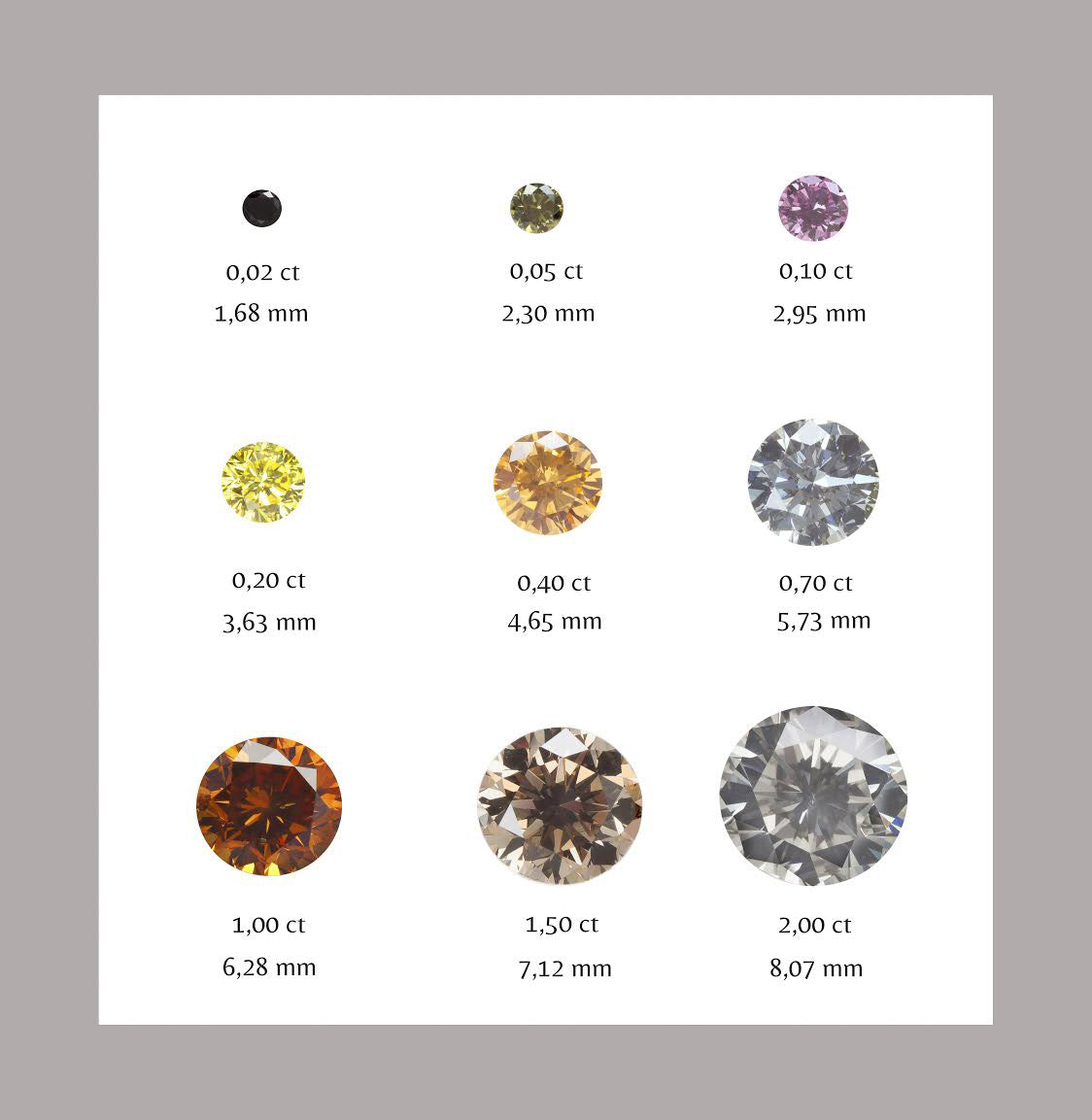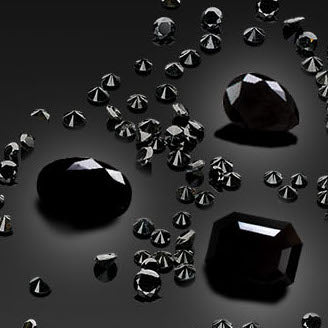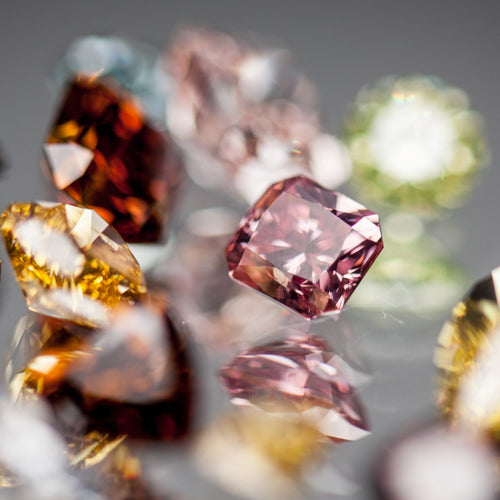Even though coloured diamonds are graded following the 4 Cs, their order of importance is different. This can be explained by the simple fact that colour is by far the most important element, and most of the time, the one that determines the value of the stone. Natural colour diamonds being much smaller than colourless ones in general, Carat can’t be regarded as the most significant criterion. Clarity must be judged differently too, since flawless diamonds are much rarer in the world of natural colour diamonds. It will only be considered important for exceptional stones. As for the Cut, it is determined according to the hue of the stone, the goal being to amplify the colour as much as possible.
Additionally to the 4 Cs, fluorescence is sometimes regarded as a notable element on natural colour diamonds certificates. Nevertheless, it is important to know that even if this phenomenon is more common amongst coloured diamonds, it has nothing to do with their quality in most cases.
1. Color

In the world of natural colour diamonds, colour is the first of the 4 Cs. Simply because when looking for a natural colour diamond, one will first look for a specific hue.
Read here about the methodology of color grading and its limits.
In general, one can say that a beautiful color diamond is a diamond that has:
maximum sparkle (i.e. whose cut best brings out its color and sparkle),
acceptable purity (i.e. no significant inclusion can be seen with the naked eye and impurities are in harmony with the stone),
uniform and harmonious color (there are no areas with stronger or weaker colors - i.e. inconsistencies in the color permeating the stone, which can result from an imperfect cut).
One should note that the color itself does not play a role in determining whether a diamond is beautiful. It really is a question of personal taste. What counts the most is how lively and harmonious a stone looks; in other words, its general aspect.
"No colour can be considered nicer than another."
2. Carat
Contrary to colorless diamonds, carat doesn’t come first when choosing a natural color diamond.
One has to keep in mind that natural color diamonds are generally smaller than white diamonds. This is the case for red, purple, cognac and pink natural colored diamonds. On the other hand, yellow, brown or olive-green diamonds can sometimes reach 10 carat.
"Depending on their color, some diamonds will be nearly impossible to find above 1 carat."
This is why the notion of carat in color diamonds must be tackled differently. The value of a natural colored diamond depending mainly on its color’s scarcity, the weight of a stone one can afford will depend on its color. For example, a Fancy light pink 1 carat natural color diamond will be worth the same price (or even less) as a 0.25 carat Fancy vivid pink one. The question of favoring color over weight is a personal choice. Sometimes, one might prefer a smaller diamond with a more saturated color to a larger stone with a lighter hue. Indeed, a more saturated color diamond stands out much more than a lighter colored one.

In the world of colorless diamonds, the aim of polishing is mainly to produce a cut stone that is as pure as possible, with a weight as close to that of the rough as possible - in order to maximize yield. With color diamonds, however, color prevails over weight. So it is not rare that weight will be sacrificed for color. Indeed, it is often possible to strengthen the intensity of the color and the sparkle of the diamond by cutting it, and some passionate diamantaires will sometimes have a stone cut four or five times before being satisfied.

3. Clarity
Even if clarity still counts in evaluating a natural colored diamond, it is much less important than in the world of colorless diamonds. It is so secondary that a lot of people who buy a natural color diamond only request a “half certificate” or a “color only report” which doesn’t indicate the stone’s clarity.
The clarity of natural colored diamonds is graded following the same grading scale used for colorless diamonds. Nevertheless, there is no comparison in evaluating a colored diamond’s clarity to evaluating the one of a white diamond. Indeed, when a flawless colorless diamond is extremely rare, a flawless colored one is ten times rarer.
As a general rule, the presence of certain impurities can be tolerated under certain conditions, the main ones being that they do not interfere with the play of color or with the sparkle of the stone, and that they are not visible to the naked eye. For example, a light-colored impurity in a dark stone, or a dark impurity in a light-colored stone will be equally visible.
"Depending on the diamond’s color, clarity is more or less tolerable."
Because of the geological conditions during their formation, red and pink natural color diamonds usually contain more inclusions than other colored diamonds. Their clarity is thus considered less important: inclusions are tolerated in red color diamonds. As for pink color diamonds, an SI grade is regarded as excellent quality and I1 is still judged good. It is also the case for cognac diamonds which practically always have a little cloud in their core. On the contrary, yellow, brown, and blue colored diamonds can lose a lot of their value if they have impurities, for they generally have less flaws.

Nevertheless, the origin of diamonds is an important element to consider. Indeed, natural colored diamonds show impurities that are typical of their provenance. For instance yellow diamonds from the Zimi mine, in Sierra Leone, inevitably have a black piqué in their core.
In any case, flawless diamonds of certain colors are extremely rare. This is why a “loupe clean” natural colored diamond is considered a great quality stone. VVS1 and VVS2 types of inclusions are not even taken into consideration - except for stones worth millions of dollars.
4. Cut
In the world of natural colored diamonds, if “Cut” is the last of the 4 Cs, it is also because it is the least important one. Indeed, this criterion doesn’t count the same way as for colorless diamonds. Here, the only aim of the cut is to enhance the hue of natural color diamonds.
As a general rule, the cut of a precious stone will increase or decrease its color. For example Ceylon sapphires, which usually have a pale color, are cut with a deeper pavilion (the lower part of the stone) than Siam sapphires, which are darker. For colorless diamonds, the aim is to obtain the clearest possible stone and in order to achieve this, very precise proportions and cutting angles have been calculated for each facet. For color diamonds however, the primary aim is to reinforce and even out the stone's color.
"When you’re cutting colored diamonds, you throw away the book."
The choice and value of types of cut are also different. On the colorless diamond market, round (brilliant) stones are worth more than fancy shapes, mainly because there is a higher loss in weight when one cuts a brilliant - 55% loss of the rough's weight for brilliant cuts against 40-45% for fancy shapes.

Concerning color diamonds, the issue is different. Except for brown natural colored diamonds which are mainly found in round cuts and melee diamonds (generally used for pavé settings), all other color diamonds are generally seen in fancy shapes - and this does not have an impact on price. The main reason for this is that natural colored diamonds are rarer, smaller, and then more expensive than rough colorless diamonds. So diamond-cutters must try to reach the best possible yield.
"The proportions that are considered ideal for colorless diamonds do not apply to color diamonds."
The shape of the cut will be determined solely as the one that will best amplify the color of a stone. A round cut is far more expensive because in order to get the equivalent intensity of color to a fancy shape, a rough diamond of a more saturated color must be used. This is explained by the fact that the ideal brilliant cut has been designed to amplify the whiteness of colorless diamonds, thus removing the slightest hint of color.

In relation to the intensification of color, fancy shapes offer more possibilities than the brilliant cut, whose proportions conform to rigorous criteria - angles, a precise number of facets etc.
Indeed, light passing through the stone encounters a number of elements which are likely to absorb certain colors - for example, nitrogen atoms absorb blue light and make the diamond look yellow (yellow is the complementary color of blue). As a result, the longer the light travels through the stone, the greater the absorption of color. A larger table will make the stone lighter colored, whereas a thicker girdle or crown will make the color more intense. This is why step cuts are less common in colored diamonds: they tend to diminish the intensity of the color. The number of facets can even be changed if this can intensify or improve the color. The cutter in fact tries to reach a balance between loss of brilliance and increase in color. All this to explain why color diamonds are most often cut in fancy shapes and less often as brilliants.
For color diamonds, the current trend is to develop new cuts which show off the colors of the stones even more - for example the Gabrielle, Lucère and Korloff cuts












